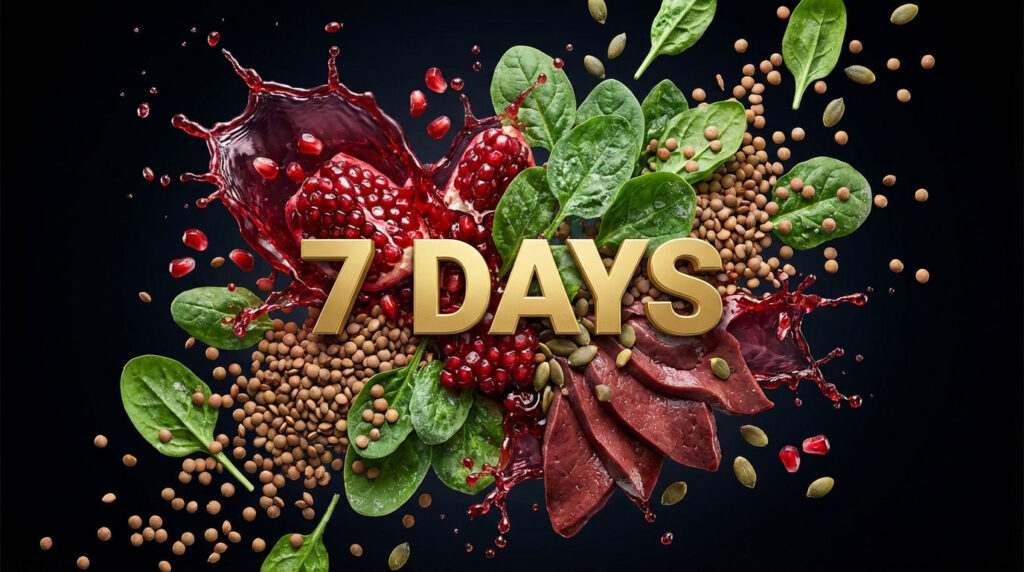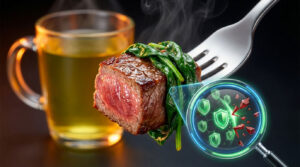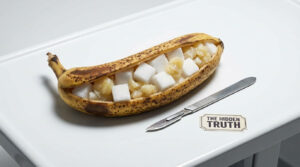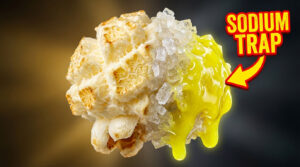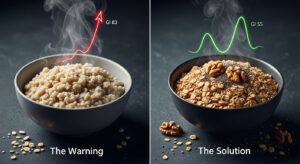You slept for a solid eight hours, yet the moment your alarm rang, you felt as if you hadn’t slept at all. You drag yourself through the morning routine, relying on a second or third cup of coffee just to feel functional. Your brain feels wrapped in cotton wool, your focus drifts, and climbing a single flight of stairs leaves you winded. When you finally visit your doctor, hoping for an answer, the standard blood tests might come back looking technically “normal.” This is one of the most frustrating experiences in modern healthcare.
Table of Contents
This phenomenon is often due to a condition known as Functional Iron Deficiency. While your hemoglobin levels may not yet be low enough to be clinically diagnosed as anemia, your iron storage tank, known as ferritin, is running on empty. You are essentially driving a car with the fuel light on. The engine is still running, but it is struggling.
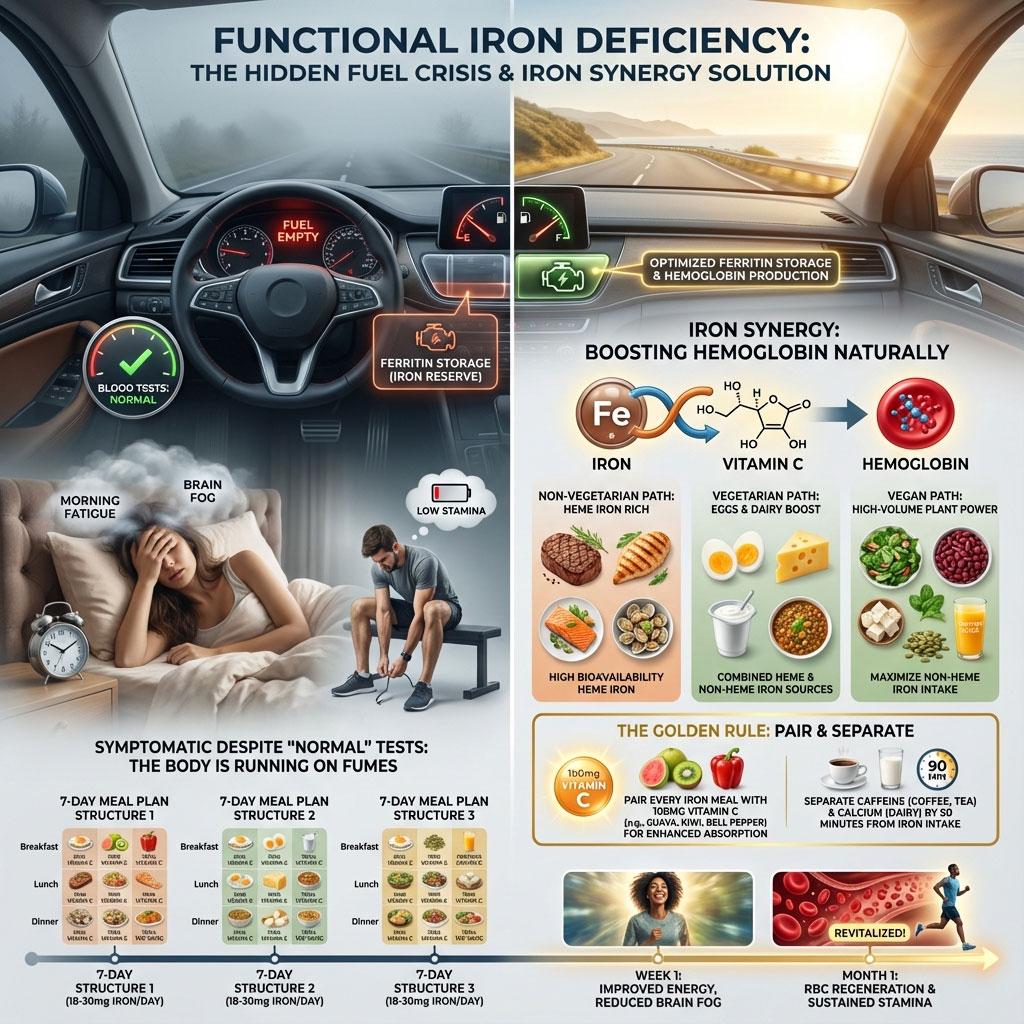
To increase hemoglobin fast and naturally, you cannot simply eat more spinach and hope for the best. You must adopt a diet strategy based on Iron Synergy. Whether you are a Non-Vegetarian focusing on Heme iron, a Vegetarian balancing eggs and dairy, or a Vegan maximizing plant volume, the biological rule remains the same. You must pair specific iron sources with 100mg of Vitamin C (such as guava, kiwi, or bell peppers) and strictly separate caffeine and calcium from your meals by 90 minutes.
This comprehensive guide is not just a list of foods. It is a strategic medical nutrition protocol. It features three distinct 7-day meal plans targeting a daily intake of 18–30mg of iron. By optimizing absorption rather than just consumption, you can begin to boost your energy levels in one week while your red blood cells regenerate over the course of the next month.
The Science of “Iron Synergy”: Why Most Diets Fail
Understanding the biology of absorption is the only way to fix chronic low iron. Most people believe that if they eat an iron-rich food, their body absorbs it. Unfortunately, the human body is notoriously inefficient at processing iron. The problem is rarely what you swallow; the problem is what actually stays in your bloodstream. This concept is called Bioavailability.

To recover, you must understand the two types of iron and the chemical keys that unlock them.
Heme Iron: The “VIP Pass”
This form of iron is found exclusively in animal tissue, specifically in meat, fish, and poultry. It is the “premium fuel” for your blood. Your body absorbs heme iron at a relatively high rate of 15–35%. The most significant advantage of heme iron is that it is structurally protected. It uses a specific transporter in the gut (the Heme Carrier Protein 1) that allows it to bypass many of the digestive inhibitors that block plant iron. According to research published in the American Journal of Clinical Nutrition, heme iron is significantly less affected by dietary factors like tea or calcium compared to non-heme iron. If you eat a steak or a piece of liver, your body absorbs that iron with relative ease.
Non-Heme Iron: The “Crowded Entrance”
This iron is found in plant foods like lentils, spinach, tofu, and fortified grains. It is the “raw material” for hemoglobin, but it is chemically different. The absorption rate for non-heme iron is shockingly low, typically ranging from 2–20%. It enters the digestive tract in a form (ferric iron) that is difficult to pass through the gut wall. Without the right chemical catalyst, up to 98% of the iron in your healthy spinach salad can be flushed out of your system unused.
The Catalyst: Vitamin C (Ascorbic Acid)
This is the biological game-changer. Vitamin C acts as a reducing agent. It chemically converts non-heme iron (ferric iron) into a soluble form (ferrous iron) that your body can absorb. A landmark study cited by the International Journal for Vitamin and Nutrition Research consistently shows that adding just 100mg of Vitamin C to a plant-based meal can increase iron absorption by 300% or more. This is equivalent to half a red bell pepper, one kiwi, or a glass of fresh orange juice. Without this pair, plant-based iron diets often fail.
The “Caffeine Gap”: The 90-Minute Rule
This is the single most common reason why foods to increase hemoglobin fail to work. Coffee, black tea, green tea, herbal teas, and wine contain compounds called tannins and polyphenols. These compounds are avid binders of iron. They attach tightly to iron molecules in your stomach, forming a large, insoluble complex that cannot pass into your bloodstream.
If you drink coffee with your breakfast eggs or tea with your oatmeal, you are neutralizing almost all the iron in that meal. To fix this, you must follow the 90-Minute Rule. You must wait at least 90 minutes after eating an iron-rich meal before drinking tea or coffee. This gives your stomach enough time to digest and absorb the iron before the inhibitors arrive.
The Inflammation Factor: Hepcidin
New research highlights a hormone called Hepcidin, which is produced by the liver. Hepcidin is the master regulator of iron entry into the blood. When your body is inflamed—due to stress, lack of sleep, chronic illness, or intense exercise—hepcidin levels rise. High hepcidin blocks iron absorption in the gut. This means that reducing inflammation through whole foods, sleep, and hydration is just as important as eating iron.
The Nutrient Support Team
Iron does not work alone. Building a red blood cell is like building a house; iron is the bricks, but you need other materials to complete the structure.
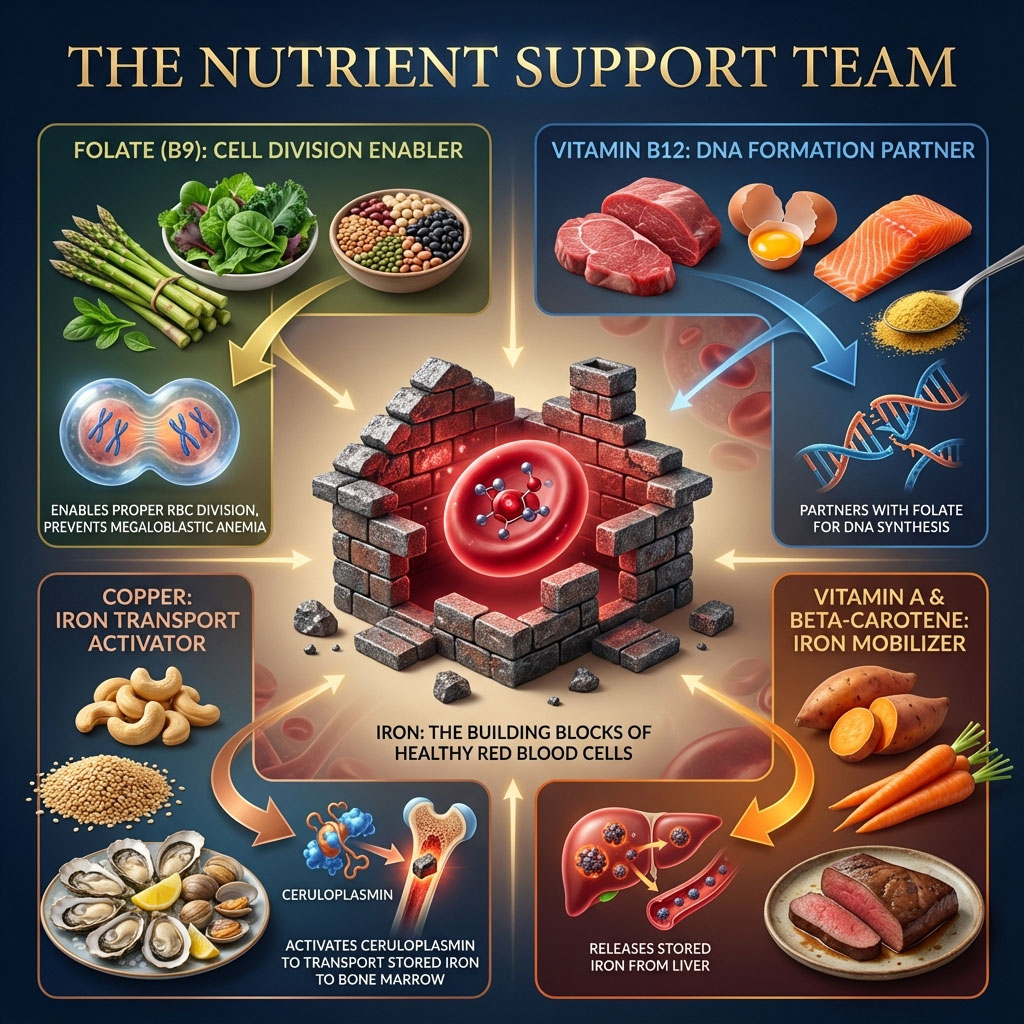
1. Folate (Vitamin B9)
Folate is essential for the division of new red blood cells. Without it, your cells become large and misshapen, leading to a condition called megaloblastic anemia. Sources include asparagus, dark leafy greens, and beans.
2. Vitamin B12 (Cobalamin)
B12 works with folate to produce DNA for new blood cells. A deficiency here can mimic iron deficiency. Sources include meat, eggs, fish, and nutritional yeast for vegans.
3. Copper
This trace mineral is often overlooked. Copper is required to create ceruloplasmin, an enzyme that transports iron from your storage sites (liver) to your bone marrow where blood is made. Without copper, your iron stays stuck in storage. Sources include cashews, sesame seeds, and shellfish.
4. Vitamin A and Beta-Carotene
These nutrients help release iron that the body has stored, making it available for the production of red blood cells. Sources include sweet potatoes, carrots, and beef liver.
Top Foods to Increase Hemoglobin (The “Hemoglobin Heroes”)
Before we look at the daily menu, you need to know which foods provide the highest return on investment. We call these the “Hemoglobin Heroes.”
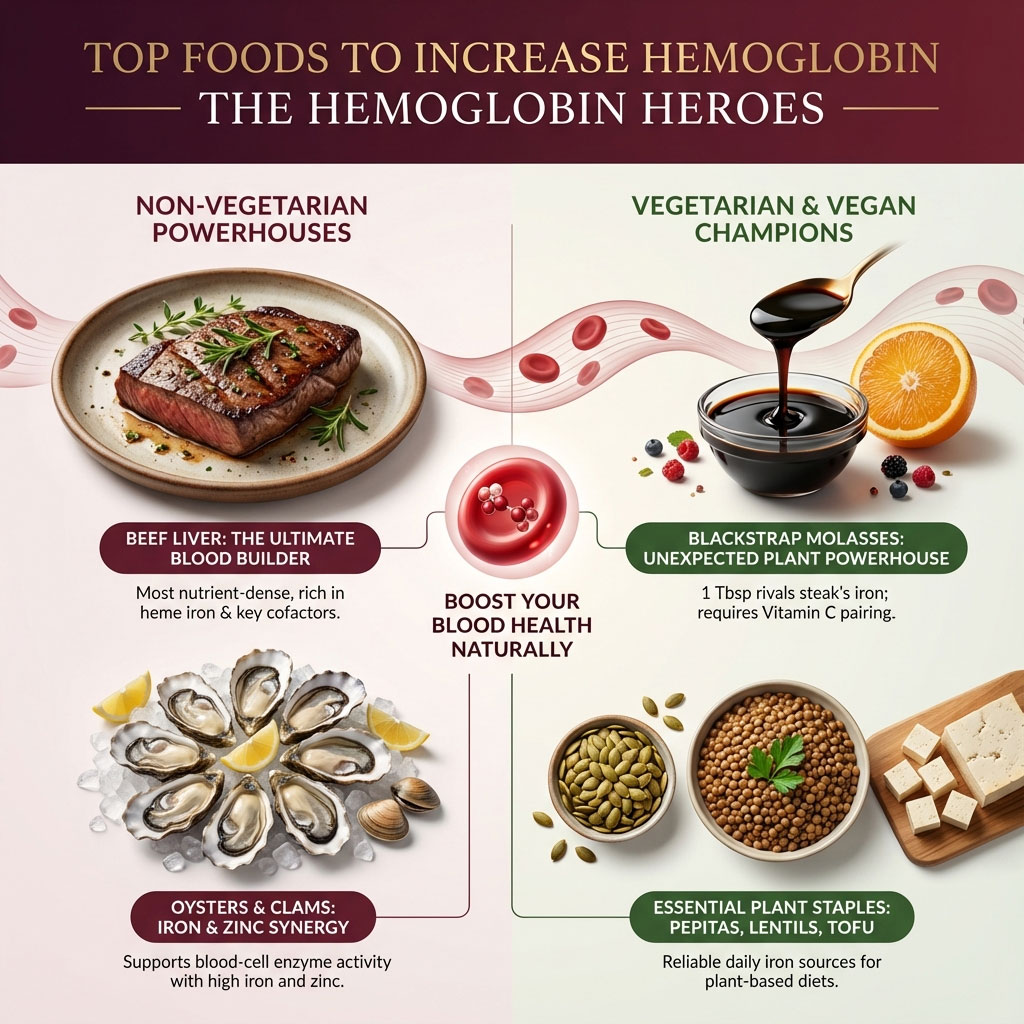
For Non-Veg eaters, the gold standard is beef liver. It is chemically dense with everything your blood needs. Oysters and clams are also powerful because they provide zinc, which supports the enzymes that build blood cells.
For Vegetarians and Vegans, the “dark horse” is Blackstrap Molasses. Just one tablespoon contains as much iron as a small serving of steak, though it requires Vitamin C to work. Pumpkin seeds (pepitas), lentils, and tofu are also staples.
Comparison Table: Iron Content by Source (USA Standards)
The following table breaks down the iron content of top foods based on standard US serving sizes. Note the difference in source type and bioavailability potential.
| Food Source | Type | Serving Size | Iron (mg) | % DV (approx) | Bioavailability |
| Beef Liver | Heme (Meat) | 3 oz | 5.0 – 15.0 mg | 28-80% | High |
| Oysters (Eastern) | Heme (Seafood) | 3 oz | 6.0 – 8.0 mg | 30-45% | High |
| White Beans (Canned) | Non-Heme (Veg) | 1 cup | 8.0 mg | 44% | Low (Needs Vit C) |
| Lentils (Cooked) | Non-Heme (Veg) | 1 cup | 6.6 mg | 37% | Low (Needs Vit C) |
| Spinach (Boiled) | Non-Heme (Veg) | 1 cup | 6.4 mg | 36% | Low (Needs Vit C) |
| Blackstrap Molasses | Non-Heme (Vegan) | 1 tbsp | 3.5 mg | 20% | Low (Needs Vit C) |
| Sardines | Heme (Seafood) | 3 oz | 2.5 mg | 14% | High |
| Pumpkin Seeds | Non-Heme (Vegan) | 1 oz | 2.5 mg | 14% | Low (Needs Vit C) |
(Data Source: USDA FoodData Central)
PROTOCOL A: The Non-Vegetarian “Heme-Accelerator” Plan
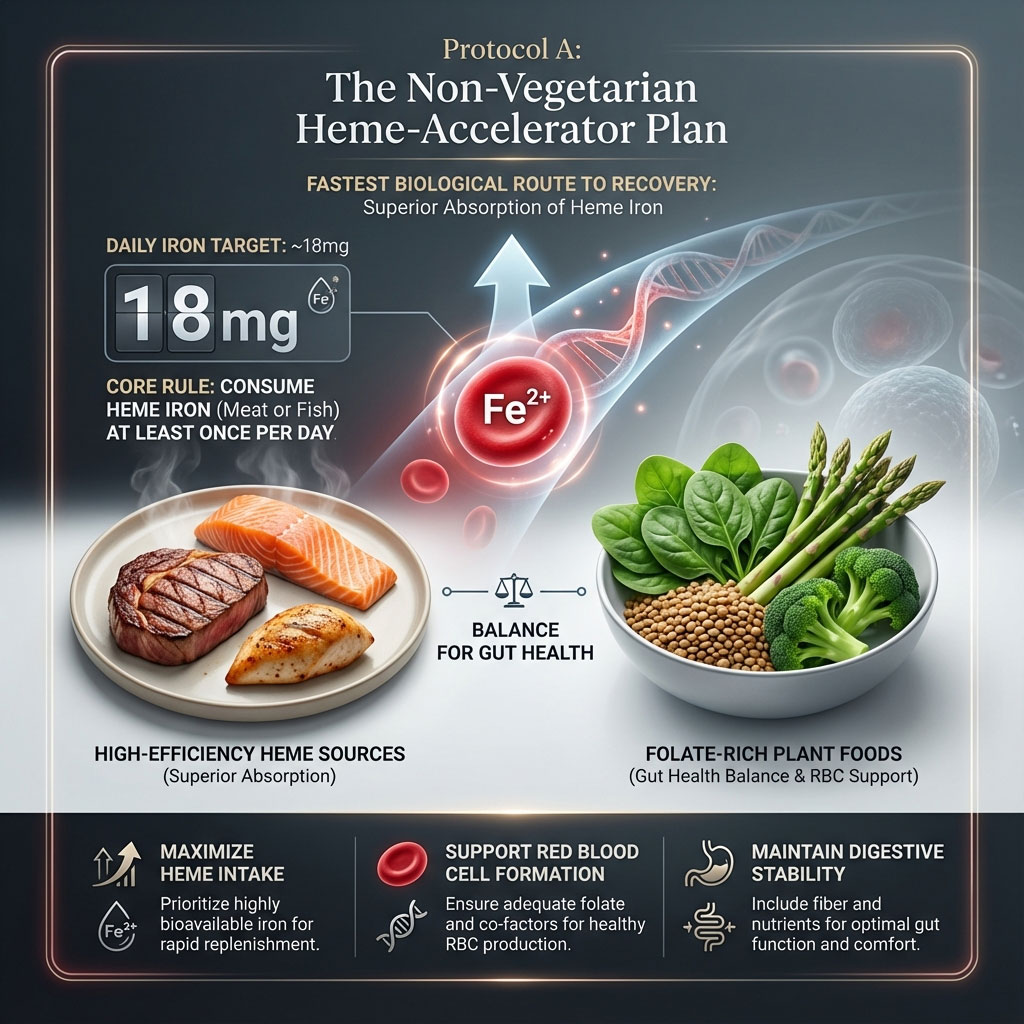
This protocol is the fastest biological route to recovery. It utilizes high-efficiency heme iron sources while balancing them with folate-rich plant foods. The goal is to maximize Heme intake while maintaining gut health.
- Daily Target: ~18mg Iron.
- Key Strategy: Eat Heme iron (meat/fish) at least once per day.
Day 1: The Organ Superfood Reset

- Breakfast: Two scrambled eggs with sautéed spinach and a 4oz glass of Orange Juice.
- Why this works: Eggs contain iron in the yolk, but the whites contain inhibitors. The Vitamin C in the juice neutralizes the inhibitors and boosts absorption of the spinach iron.
- Lunch: Grilled Chicken Breast salad with pumpkin seeds, sliced red bell peppers, and lemon vinaigrette.
- Why this works: Chicken provides heme iron, while the pumpkin seeds add a mineral boost. The red peppers are the Vitamin C activator.
- Dinner:Beef Liver & Onions (3oz). Sautéed with onions and served with steamed broccoli.
- Why this works: Liver is the most potent source of iron and Vitamin A available. Broccoli provides the Vitamin C to catch any non-heme iron present in the meal.
- Snack: Dried Apricots and a handful of almonds.
Day 2: The Shellfish Matrix
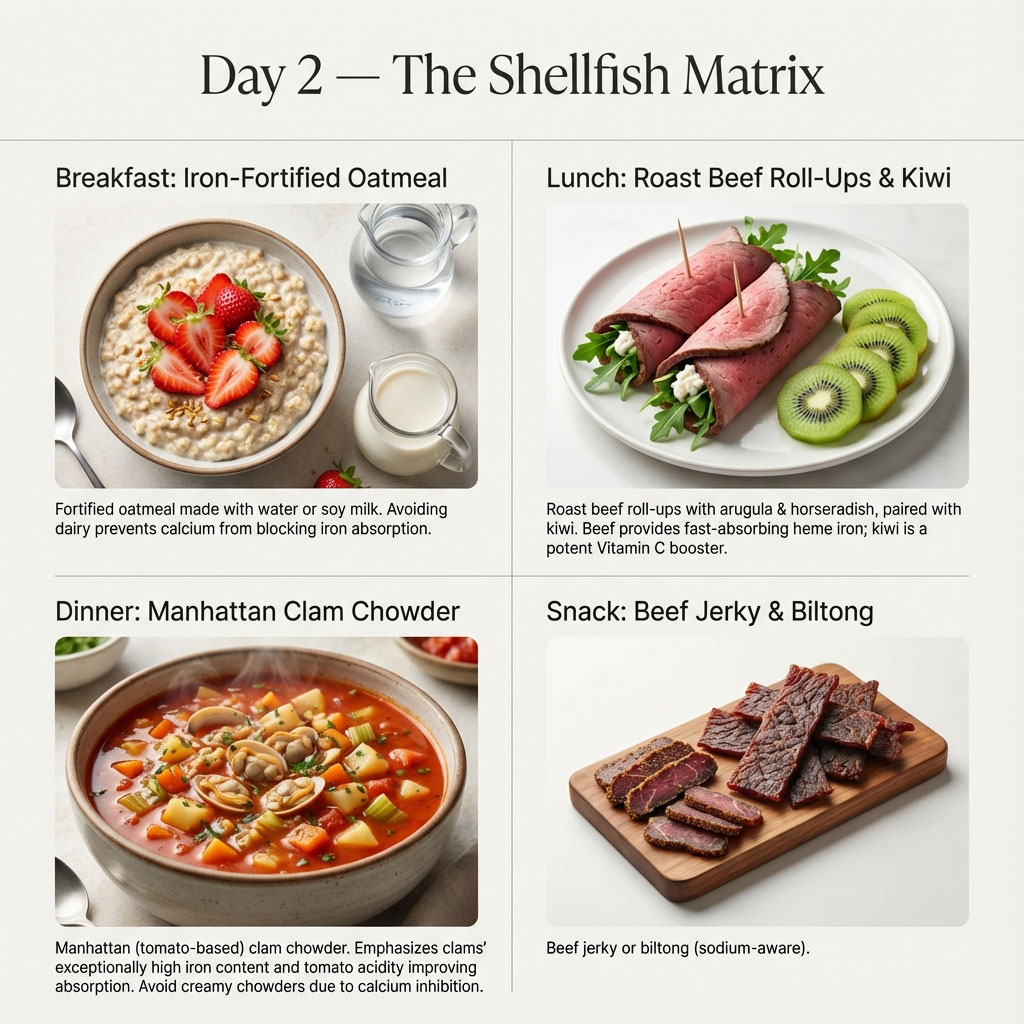
- Breakfast: Fortified Oatmeal prepared with water or soy milk (avoid dairy milk), topped with strawberries.
- Why this works: Dairy calcium blocks iron. Using water or plant milk prevents this block.
- Lunch: Roast Beef Roll-ups. Deli roast beef wrapped around arugula with a smear of horseradish. Side of kiwi slices.
- Why this works: The beef provides immediate heme iron. The kiwi is a high-powered Vitamin C dessert.
- Dinner:Manhattan Clam Chowder (Tomato-based).
- Why this works: Clams are incredibly high in iron, and the acidic tomato broth boosts absorption. Creamy chowders should be avoided because the calcium in the cream inhibits the iron.
- Snack: Beef Jerky (check sodium levels) or Biltong.
Day 3: The “Red & Green” Synergy
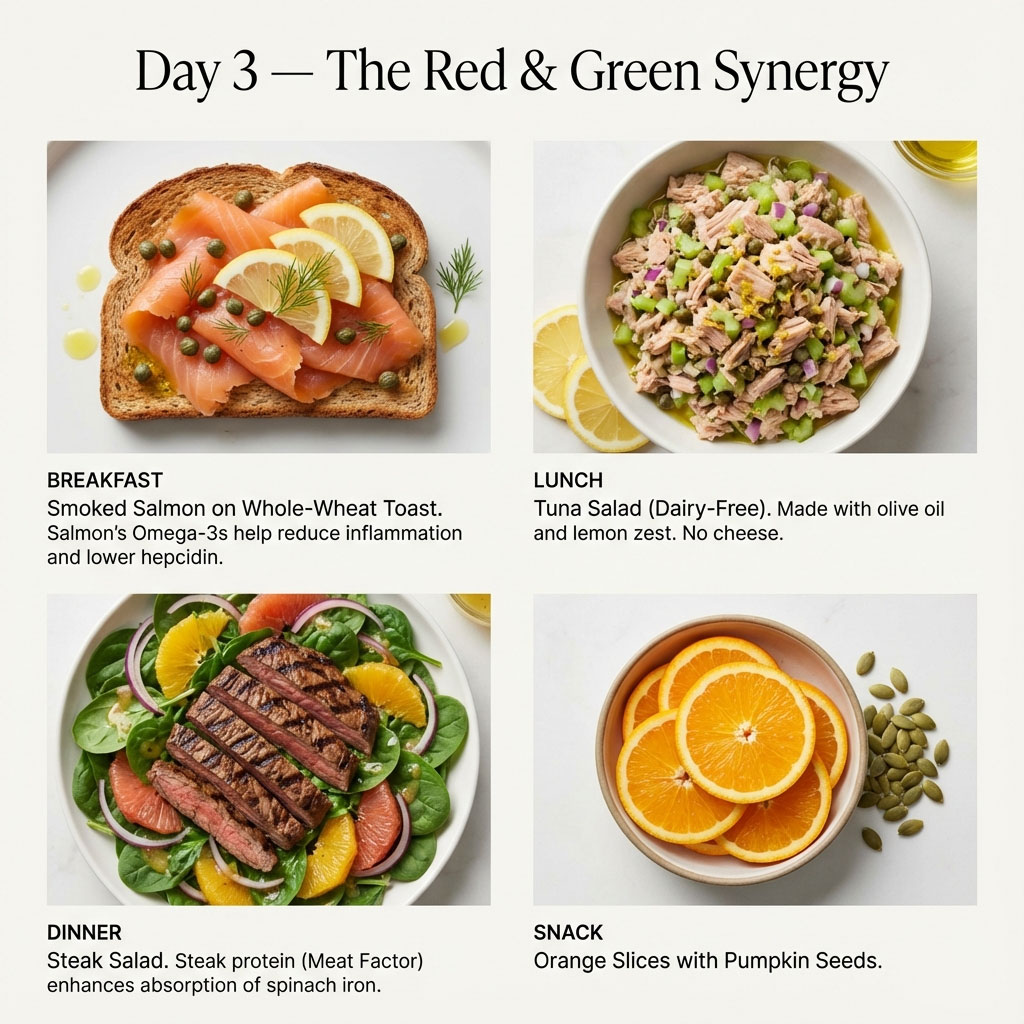
- Breakfast: Smoked Salmon on whole-wheat toast with capers and a squeeze of lemon.
- Why this works: Salmon provides anti-inflammatory Omega-3s, which helps lower hepcidin levels.
- Lunch: Leftover Clam Chowder or Tuna Salad made with olive oil and lemon zest (no cheese).
- Dinner:Steak Salad. 4oz Grilled Flank Steak served over a bed of baby spinach, red onions, and citrus dressing.
- Why this works: The “Meat Factor” phenomenon means the protein in the steak actually helps your body absorb the iron from the spinach.
- Snack: Orange slices and pumpkin seeds.
Day 4: Poultry & Peppers
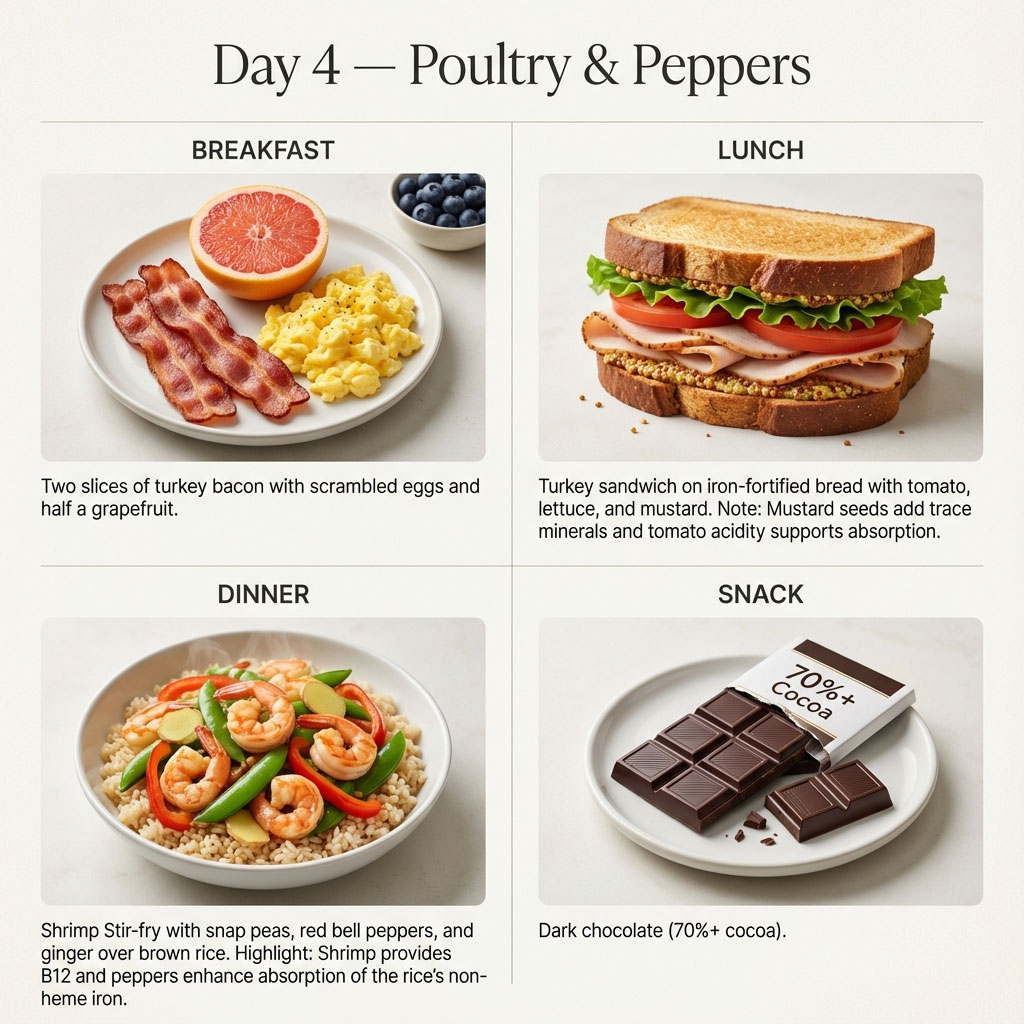
- Breakfast: Turkey Bacon (2 slices) with scrambled eggs and half a Grapefruit.
- Lunch: Turkey Sandwich on iron-fortified bread with tomato, lettuce, and mustard.
- Why this works: Mustard seeds contain small amounts of minerals, and the tomato adds acidity.
- Dinner:Shrimp Stir-fry. Shrimp cooked with snap peas, red bell peppers, and ginger served over brown rice.
- Why this works: Shrimp is low in calories but high in B12. The peppers unlock the non-heme iron in the rice.
- Snack: Dark Chocolate (70% cocoa or higher).
Day 5: The Anti-Inflammatory (Fish)

- Breakfast: Berry Smoothie: Mixed berries, spinach, collagen protein, and water.
- Lunch: Sardines on Toast. Mash sardines with lemon juice and spread on toast. Top with roasted red peppers.
- Why this works: Sardines are a powerhouse of calcium and iron, but the lemon helps manage the absorption. The peppers are mandatory here.
- Dinner: Lamb Chops. Grilled lamb (which has higher iron than chicken) with grilled asparagus and sweet potato.
- Snack: Hard-boiled egg sprinkled with paprika.
Day 6: Ground Beef & Greens
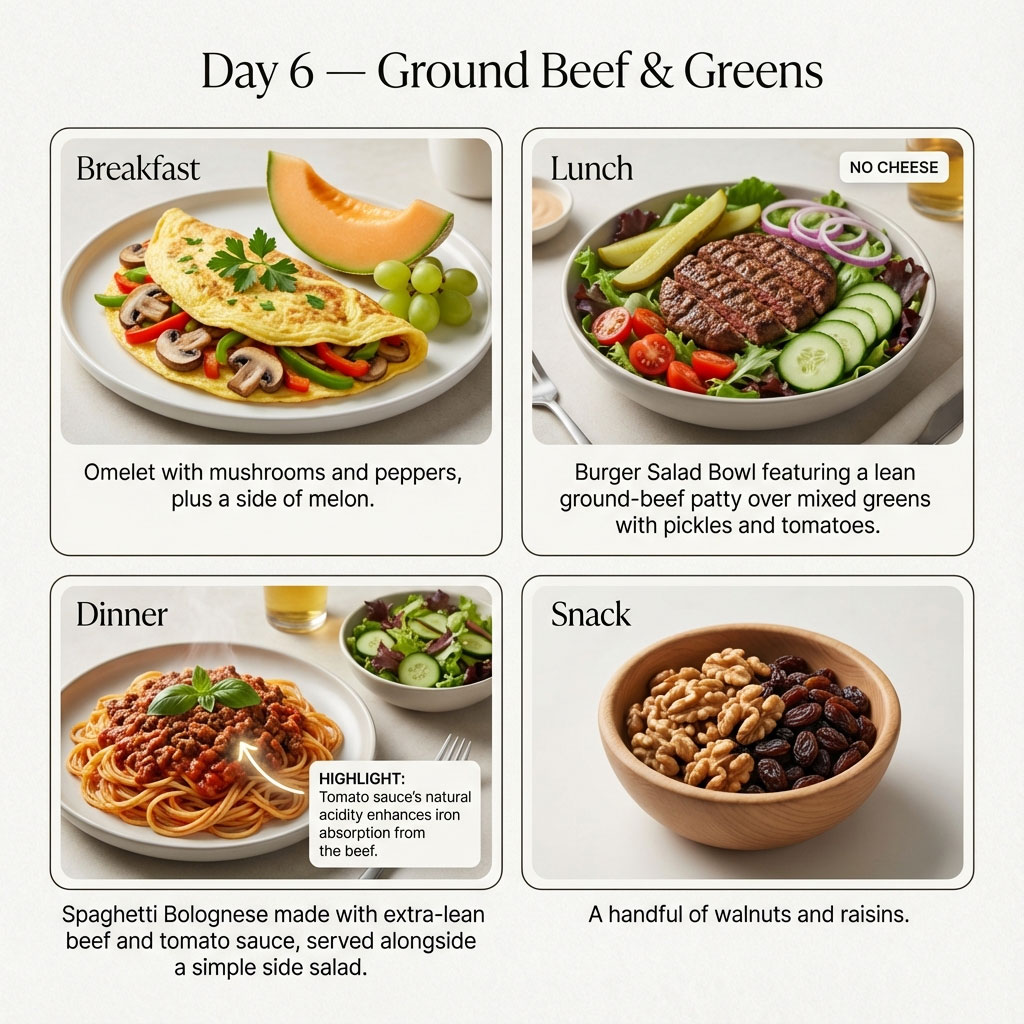
- Breakfast: Omelet with mushrooms and peppers. Side of melon.
- Lunch: Burger Salad Bowl. Lean ground beef patty over mixed greens, pickles, and tomatoes. No cheese.
- Dinner:Spaghetti Bolognese. Meat sauce made with extra lean beef and tomato sauce. Serve with a side salad.
- Why this works: The tomato sauce is acidic, promoting iron uptake from the beef.
- Snack: Handful of walnuts and raisins.
Day 7: Maintenance & Gut Health

- Breakfast: Fortified Cereal with almond milk and banana.
- Lunch: Grilled Chicken Thighs (dark meat has more iron than white meat) with coleslaw.
- Dinner:Bone Broth Stew. Slow-cooked beef stew with carrots, potatoes, and celery.
- Why this works: Bone broth supports gut lining health. A healthy gut absorbs nutrients better.
- Snack: Sliced apple with almond butter.
PROTOCOL B: The Vegetarian “Bioavailability-First” Plan
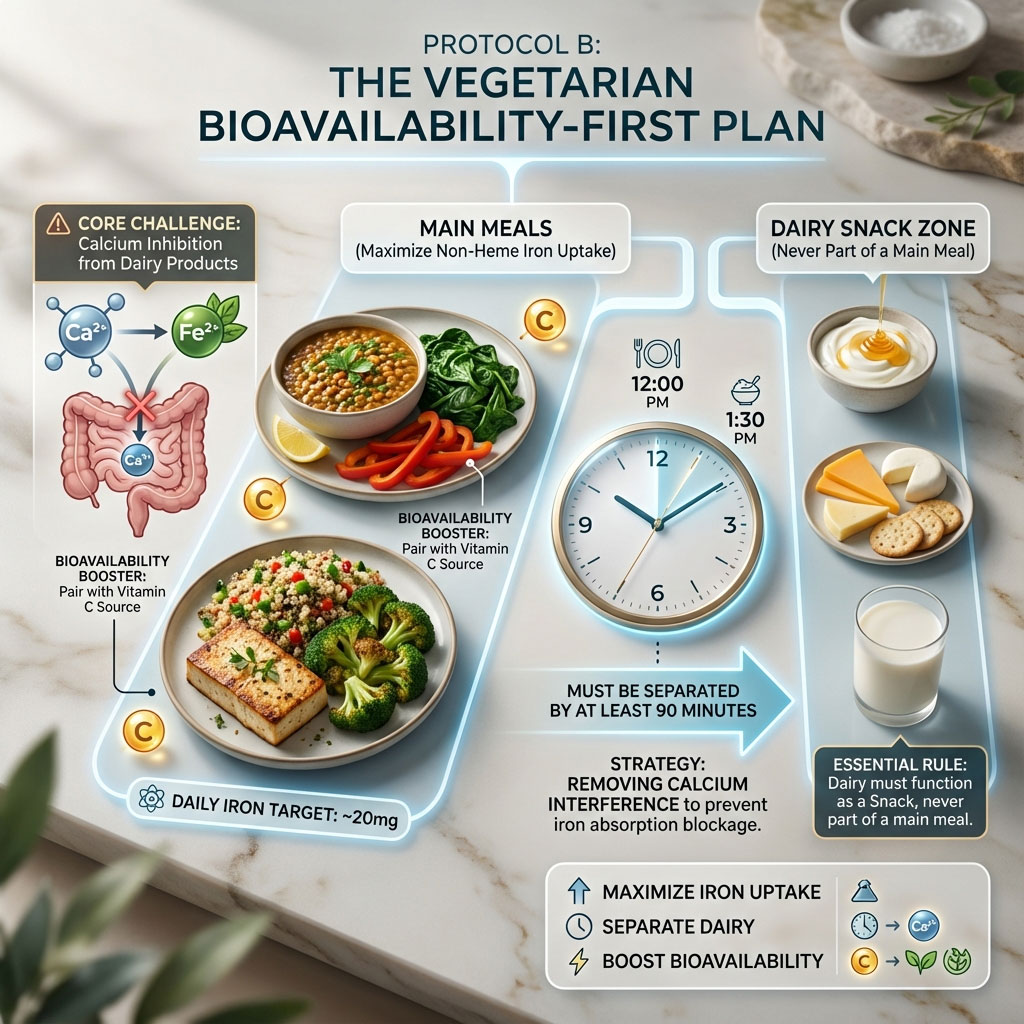
If you follow a vegetarian diet, your primary challenge is calcium. Dairy products like cheese and yogurt are staples for many vegetarians, but calcium is a potent iron inhibitor. The core rule of this 7-day meal plan to increase hemoglobin is that dairy acts as a Snack (eaten alone), not a Meal companion.
- Daily Target: ~20mg Iron.
- Key Strategy: Dairy is separated from main meals by at least 90 minutes.
Day 1: The Legume Load
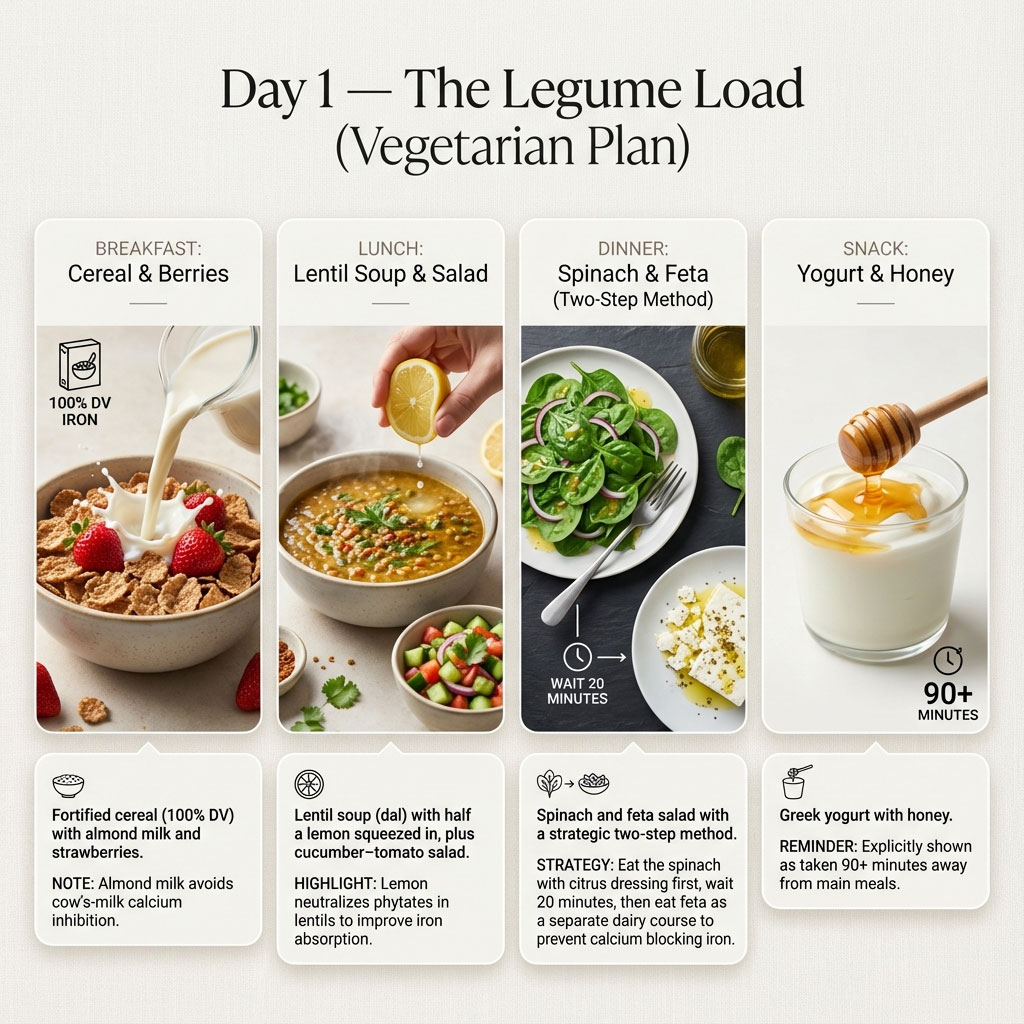
- Breakfast:Fortified Cereal (check label for 100% DV) with Almond Milk and strawberries.
- Why this works: Cow’s milk can inhibit iron. Almond milk has significantly less calcium interference.
- Lunch:Lentil Soup (Dal). Squeeze half a fresh lemon into the bowl before eating. Side of cucumber and tomato salad.
- Why this works: Lentils have high iron but also phytates. The lemon juice neutralizes the phytates.
- Dinner: Spinach and Feta Salad—but with a strategic twist. Eat the spinach salad with citrus dressing first, wait 20 minutes, then have the cheese/dairy as a “dessert” or separate course.
- Snack: Greek Yogurt with honey (Eaten at least 90 mins away from lunch/dinner).
Day 2: The Egg & Guava
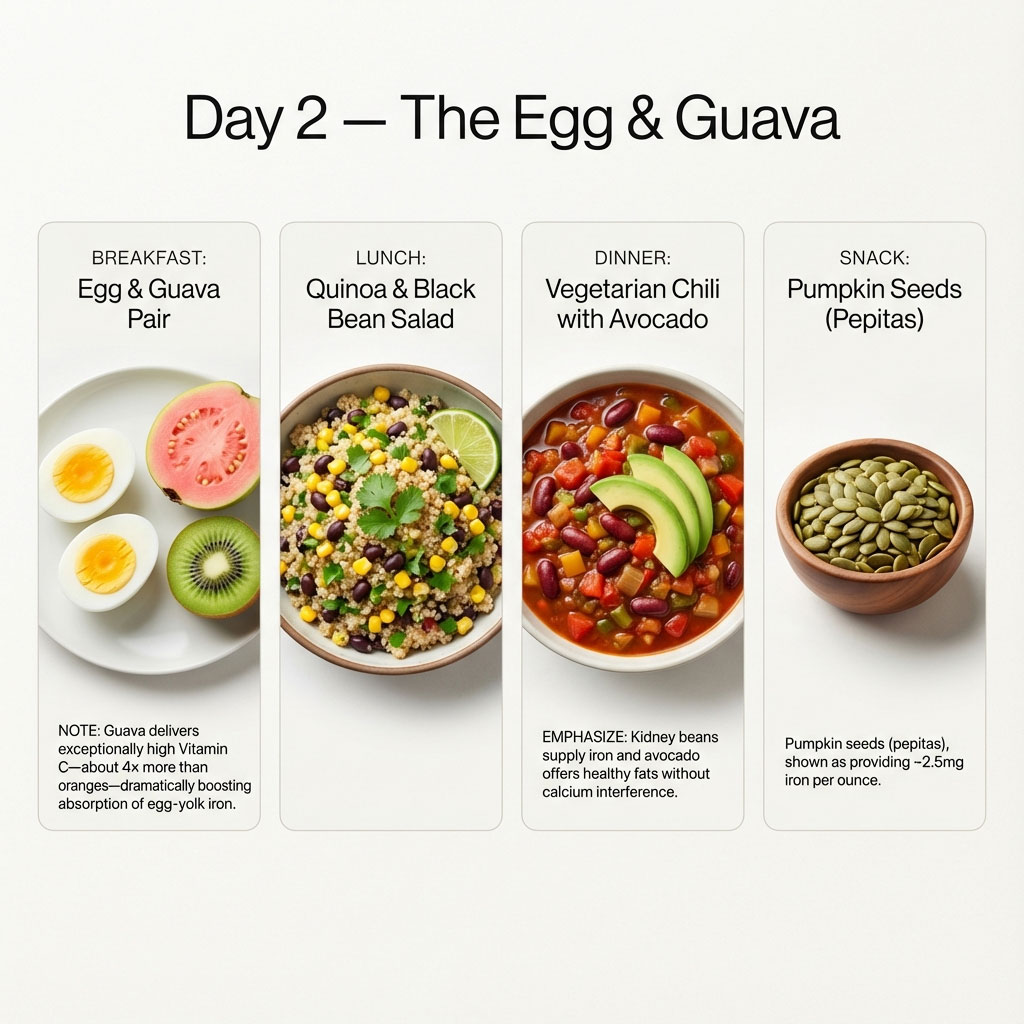
- Breakfast: Two Hard Boiled Eggs eaten with a whole Guava or Kiwi.
- Why this works: Guava has 4x the Vitamin C of oranges. This massive dose of C forces the egg yolk iron into your system.
- Lunch: Quinoa Salad with black beans, corn, cilantro, and lime juice dressing.
- Dinner:Vegetarian Chili. Kidney beans, tomatoes, and bell peppers. Top with avocado instead of sour cream.
- Why this works: Kidney beans are excellent iron sources. Avocado provides healthy fats without the calcium block of sour cream.
- Snack: Pumpkin Seeds (Pepitas). One ounce provides ~2.5mg iron.
Day 3: The Leafy Green Hack

- Breakfast: Green Smoothie: Spinach, pineapple, chia seeds, and coconut water.
- Lunch: Egg Salad Sandwich on whole-grain bread. Add sliced tomatoes inside the sandwich for Vitamin C.
- Dinner:Sautéed Spinach & Chickpea Curry. Wilt the spinach into a tomato-based curry. Serve with rice.
- Why this works: Raw spinach contains oxalates which bind iron. Cooking or wilting the spinach breaks down these oxalates, releasing the iron.
- Snack: Cheese stick (Consumed 90 mins after dinner).
Day 4: Soy Power
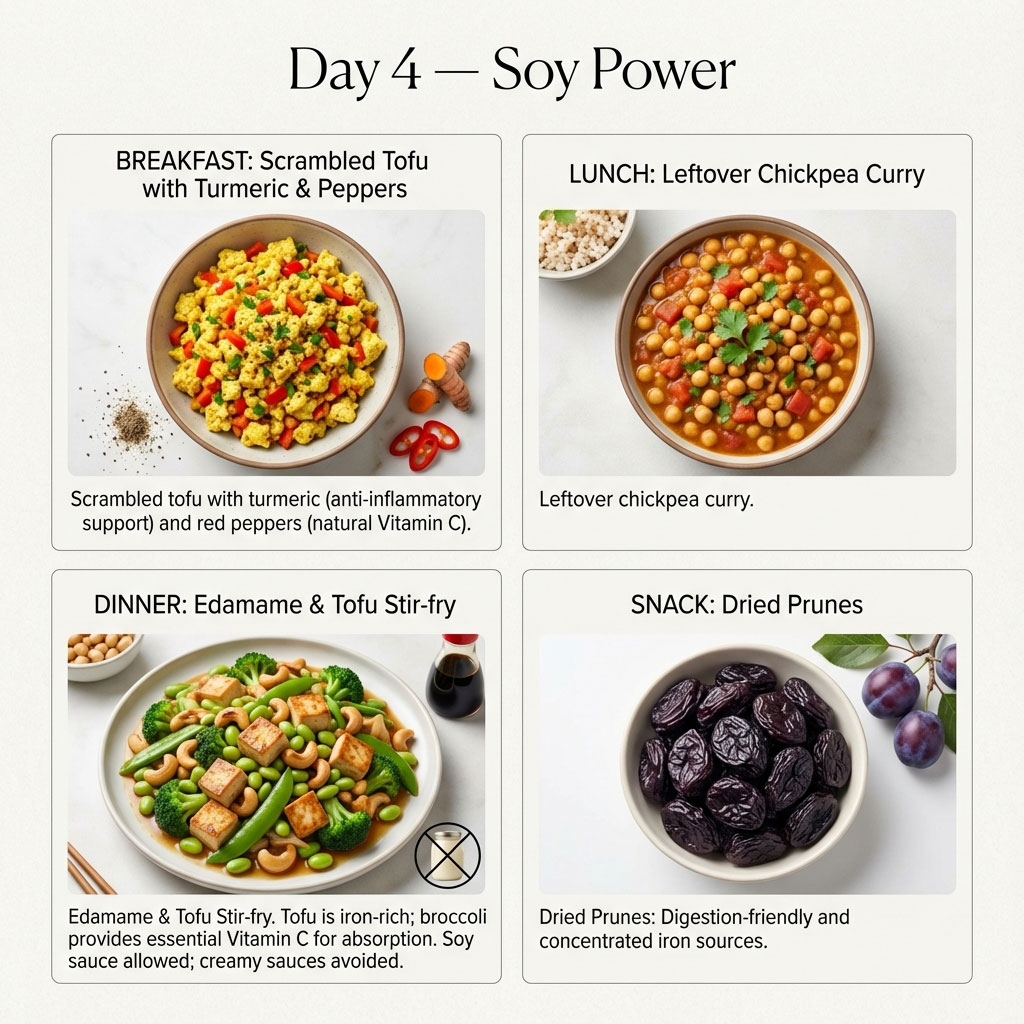
- Breakfast: Scrambled Tofu with turmeric (anti-inflammatory) and red peppers.
- Lunch: Leftover Chickpea Curry.
- Dinner:Edamame & Tofu Stir-fry. Firm tofu fried with cashews, broccoli, and snap peas. Soy sauce is fine, but avoid creamy sauces.
- Why this works: Tofu is rich in iron, and broccoli provides the necessary C.
- Snack: Dried Prunes. Prunes are well known for digestive health but are also concentrated iron sources.
Day 5: The “No-Cheese” Pasta

- Breakfast: Oatmeal with walnuts and blueberries.
- Lunch: Hummus Plate. Large serving of hummus with red bell pepper strips and carrot sticks.
- Dinner:Whole Wheat Pasta with Marinara sauce and White Cannellini Beans. Skip the Parmesan cheese.
- Why this works: White beans are incredibly high in iron. Adding them to pasta makes a complete protein.
- Snack: Cottage Cheese with peaches (Separate from main meals).
Day 6: The Super Seed Day
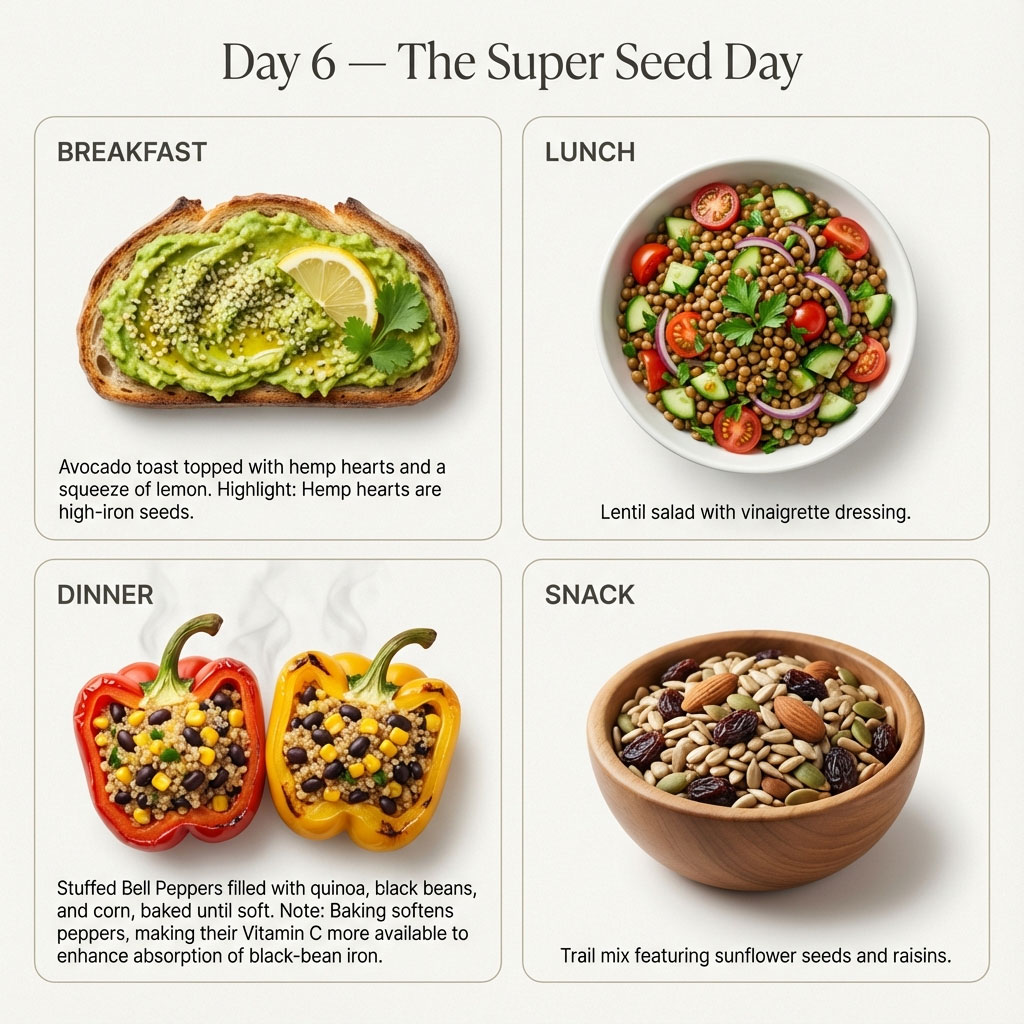
- Breakfast: Avocado Toast topped with Hemp Hearts (high iron seeds) and a squeeze of lemon.
- Lunch: Lentil Salad with vinaigrette dressing.
- Dinner:Stuffed Bell Peppers. Peppers stuffed with quinoa, black beans, and corn. Baked until soft.
- Why this works: Baking the peppers softens them, making their Vitamin C readily available to mix with the black bean iron.
- Snack: Trail mix with sunflower seeds and raisins.
Day 7: Maintenance

- Breakfast: Poached eggs on toast with grilled tomatoes.
- Lunch: Veggie Burger (Look for pea protein based) on a bun with pickles and lettuce.
- Dinner: Sweet Potato & Black Bean Tacos. Corn tortillas with black beans and roasted sweet potato. Salsa verde topping.
- Snack: Popcorn sprinkled with nutritional yeast (often fortified with B12).
PROTOCOL C: The Vegan “Volume & Synergy” Plan

The vegan diet to increase hemoglobin requires volume. Because plant iron has lower bioavailability (2–10%), you need to eat more of it. A vegan generally needs to consume approximately 1.8 times the iron of a meat-eater to absorb the same amount.
- Daily Target: ~27–30mg Iron.
- Key Strategy: Use Blackstrap Molasses and Cast Iron Cookware.
Day 1: The Molasses Miracle

- Breakfast:Molasses Oatmeal. Oatmeal cooked with water or soy milk, stirred with 1 tbsp Blackstrap Molasses. Top with strawberries.
- Why this works: Blackstrap molasses is a byproduct of sugar refining that retains all the minerals. One tablespoon offers 3.5mg of iron. The strawberries provide the Vitamin C kick.
- Lunch: Kale and Quinoa Salad with pumpkin seeds and orange segments.
- Dinner:Cast Iron Chili. Black beans and tomatoes simmered in a cast iron skillet for 45 mins.
- Why this works: The acidity of the tomatoes leaches safe dietary iron from the skillet, increasing the meal’s iron content by roughly 16%.
- Snack: Dried Figs.
Day 2: The Vitamin C Bomb
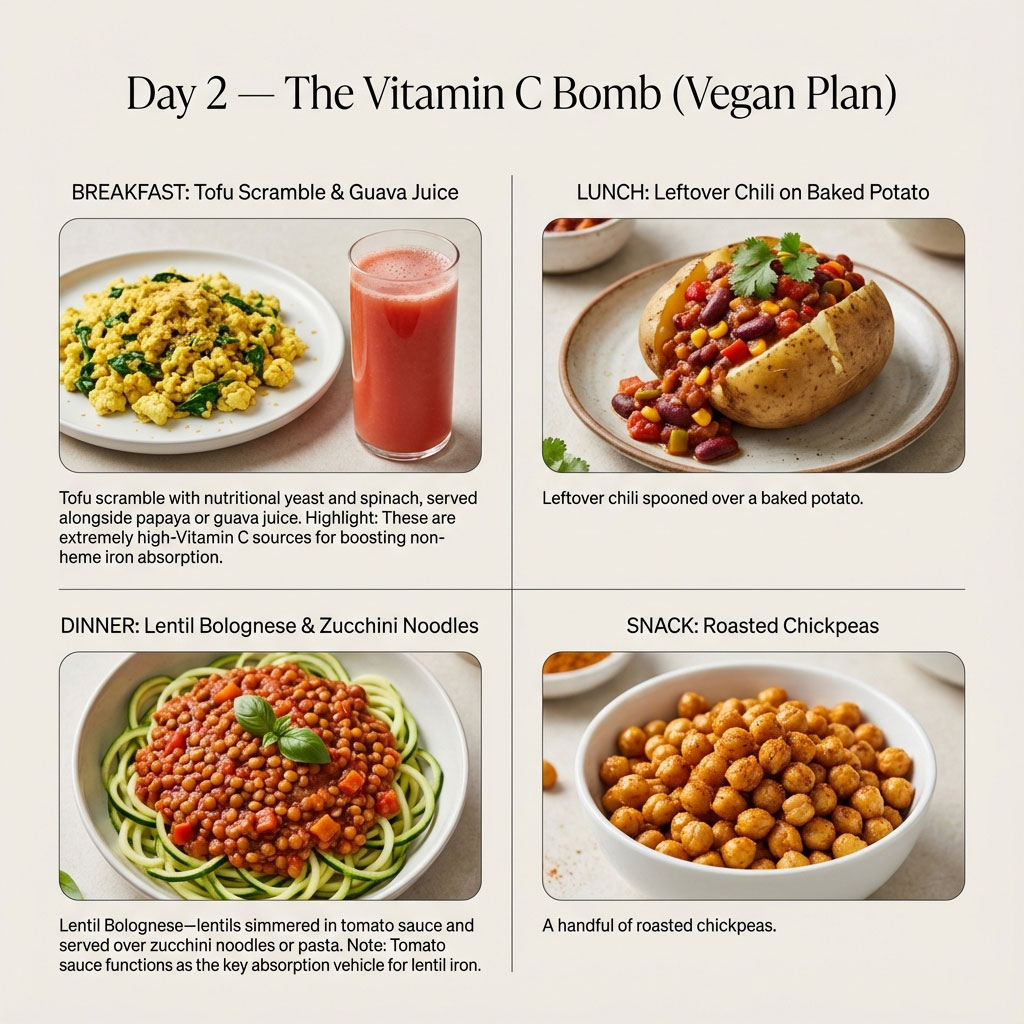
- Breakfast: Tofu Scramble with nutritional yeast, spinach, and a side of Papaya or Guava Juice.
- Lunch: Leftover Chili over a baked potato.
- Dinner:Lentil Bolognese. Lentils cooked in tomato sauce served over zucchini noodles or pasta.
- Why this works: Lentils replace the meat, and the tomato sauce acts as the absorption vehicle.
- Snack: Handful of Roasted Chickpeas.
Day 3: The Ancient Grain
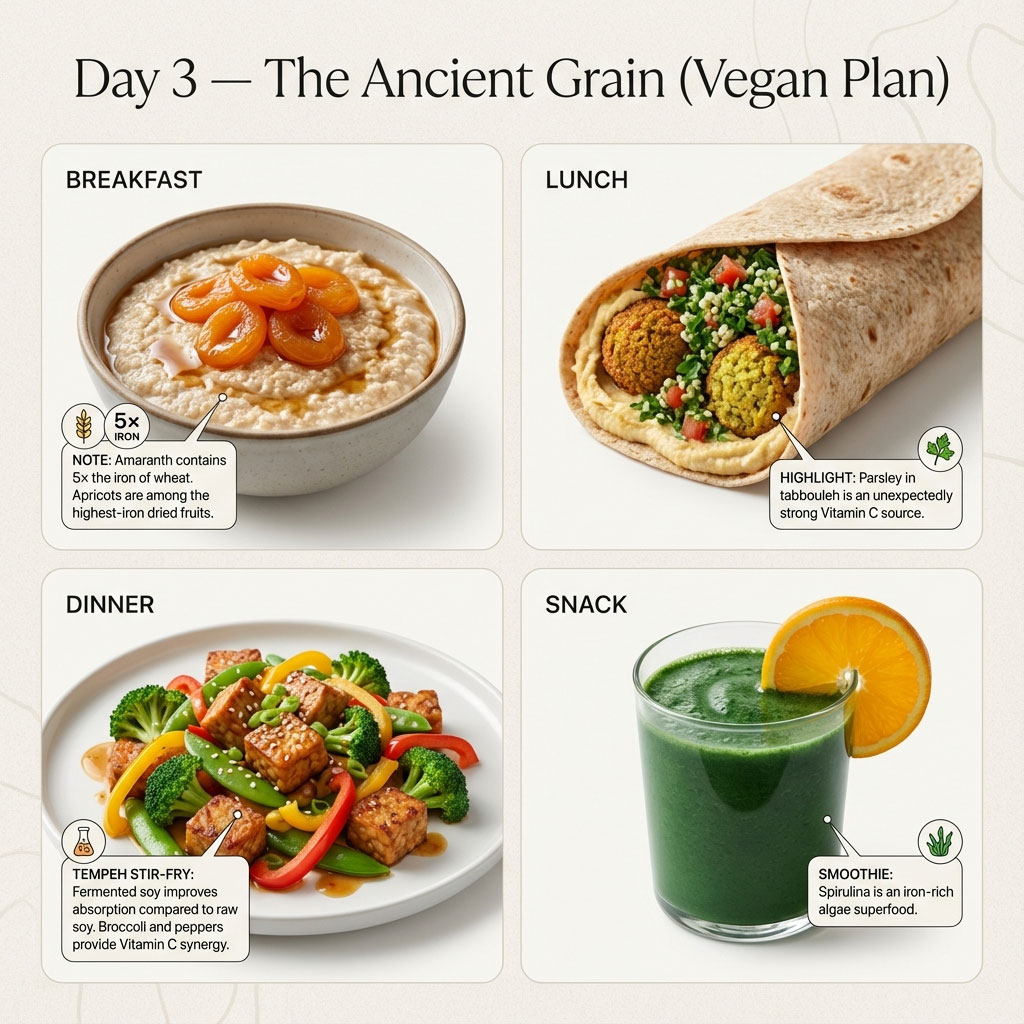
- Breakfast:Amaranth Porridge. Amaranth has 5x the iron of wheat. Cook like oats, top with dried apricots.
- Why this works: Switching grains is an easy way to boost intake without changing your routine. Apricots are one of the best dried fruits for iron.
- Lunch: Hummus and Falafel wrap with tabbouleh.
- Why this works: Parsley (in tabbouleh) is surprisingly high in Vitamin C.
- Dinner: Tempeh Stir-Fry. Fermented soy (tempeh) absorption is better than raw soy. Stir fry with broccoli and peppers.
- Snack: Smoothie with Spirulina and Orange Juice. Spirulina is an algae superfood rich in iron.
Day 4: The “Soak & Sprout”
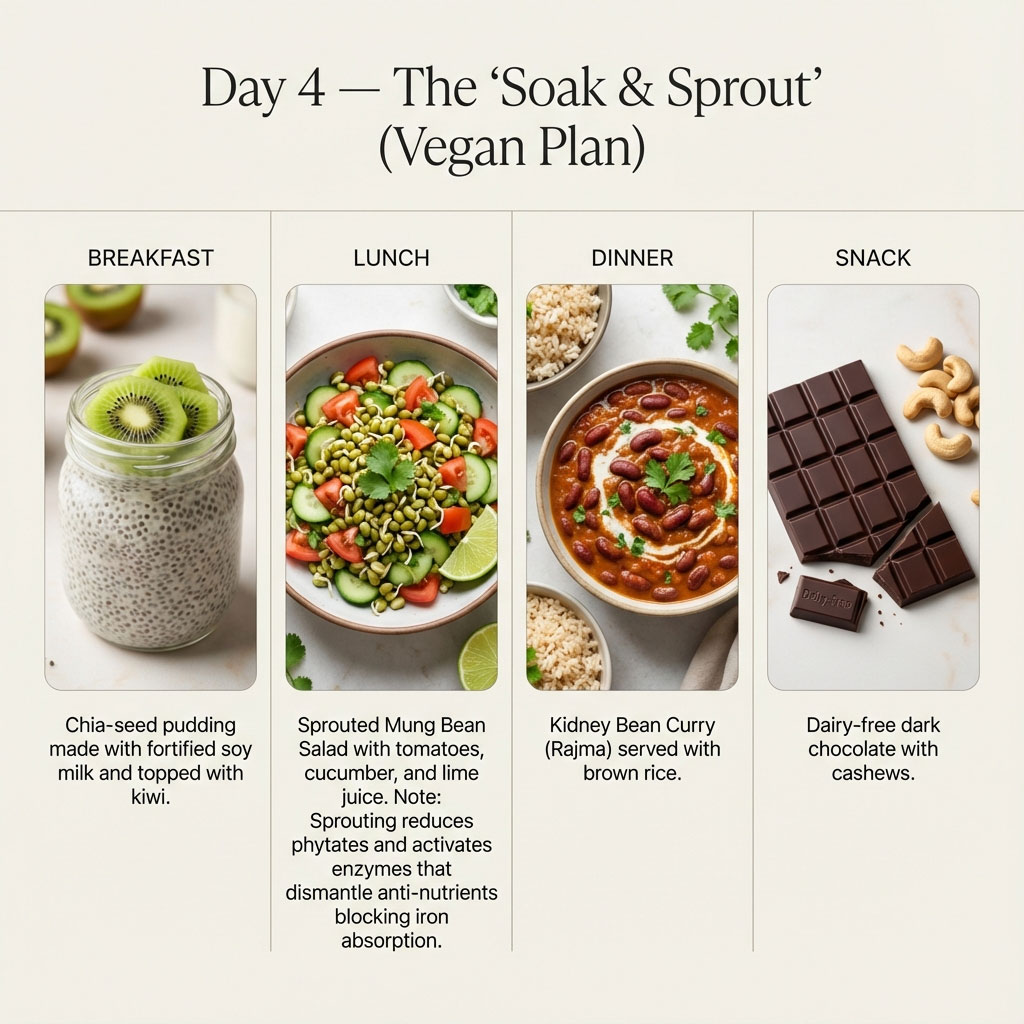
- Breakfast: Chia Seed Pudding made with fortified soy milk and topped with kiwi.
- Lunch:Sprouted Mung Bean Salad. Sprouted beans have fewer phytates than non-sprouted beans. Mix with tomatoes, cucumber, and lime juice.
- Why this works: Sprouting activates enzymes that break down the “anti-nutrients” that block iron.
- Dinner: Kidney Bean Curry (Rajma) with brown rice.
- Snack: Dark Chocolate (dairy-free) and Cashews.
Day 5: Green Volume

- Breakfast: Smoothie: Beetroot, Dates, Ginger, and Orange. (The “Blood Builder”).
- Why this works: Beetroot contains nitrates that improve blood flow, while dates provide natural sweetness and iron.
- Lunch: White Bean and Kale Soup.
- Dinner: Tofu & Broccoli in Garlic Sauce. Served with brown rice. Broccoli provides the C to unlock Tofu’s iron.
- Snack: Pumpkin Seeds (Pepitas).
Day 6: The Iron Skillet Return
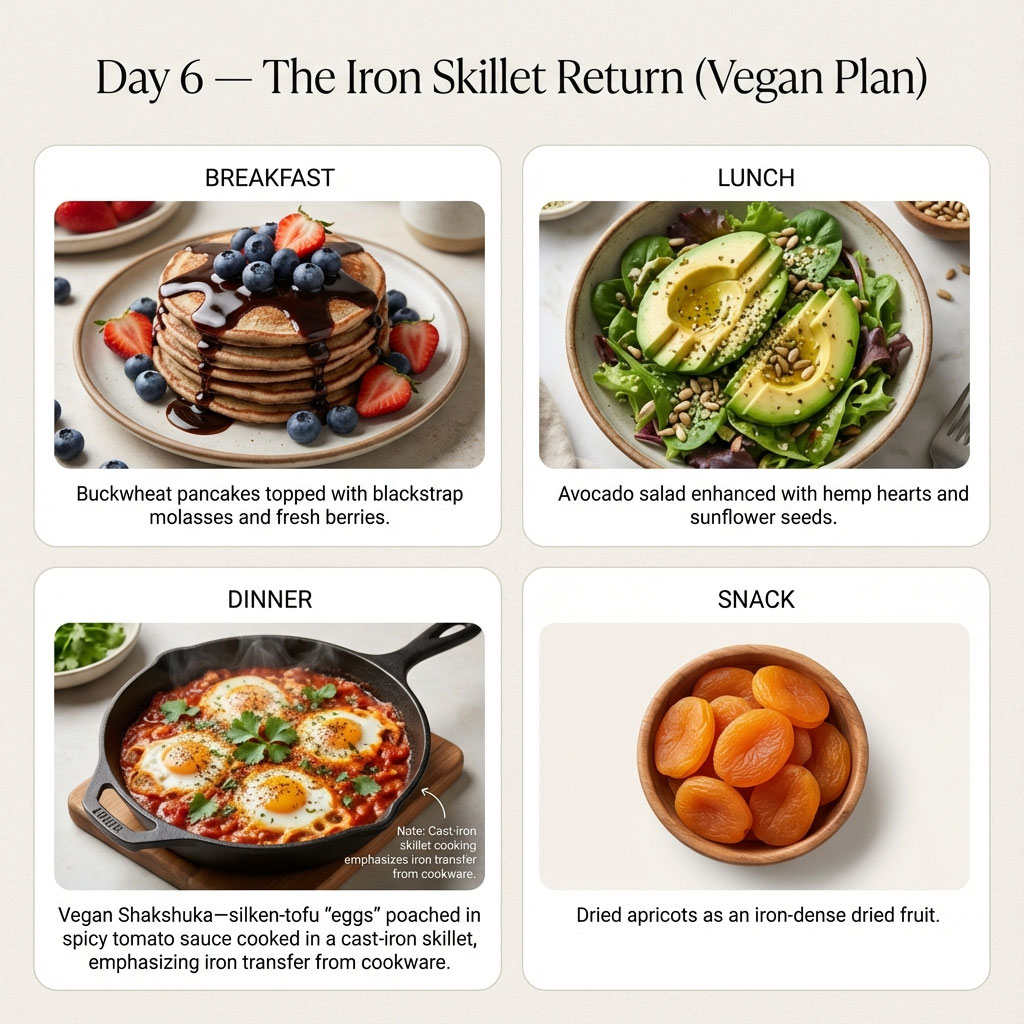
- Breakfast: Buckwheat Pancakes topped with molasses and berries.
- Lunch: Avocado Salad with Hemp hearts and sunflower seeds.
- Dinner: Shakshuka (Vegan version). Tofu silken “eggs” poached in a spicy tomato sauce cooked in a Cast Iron pan.
- Snack: Dried Apricots.
Day 7: Maintenance & Recovery
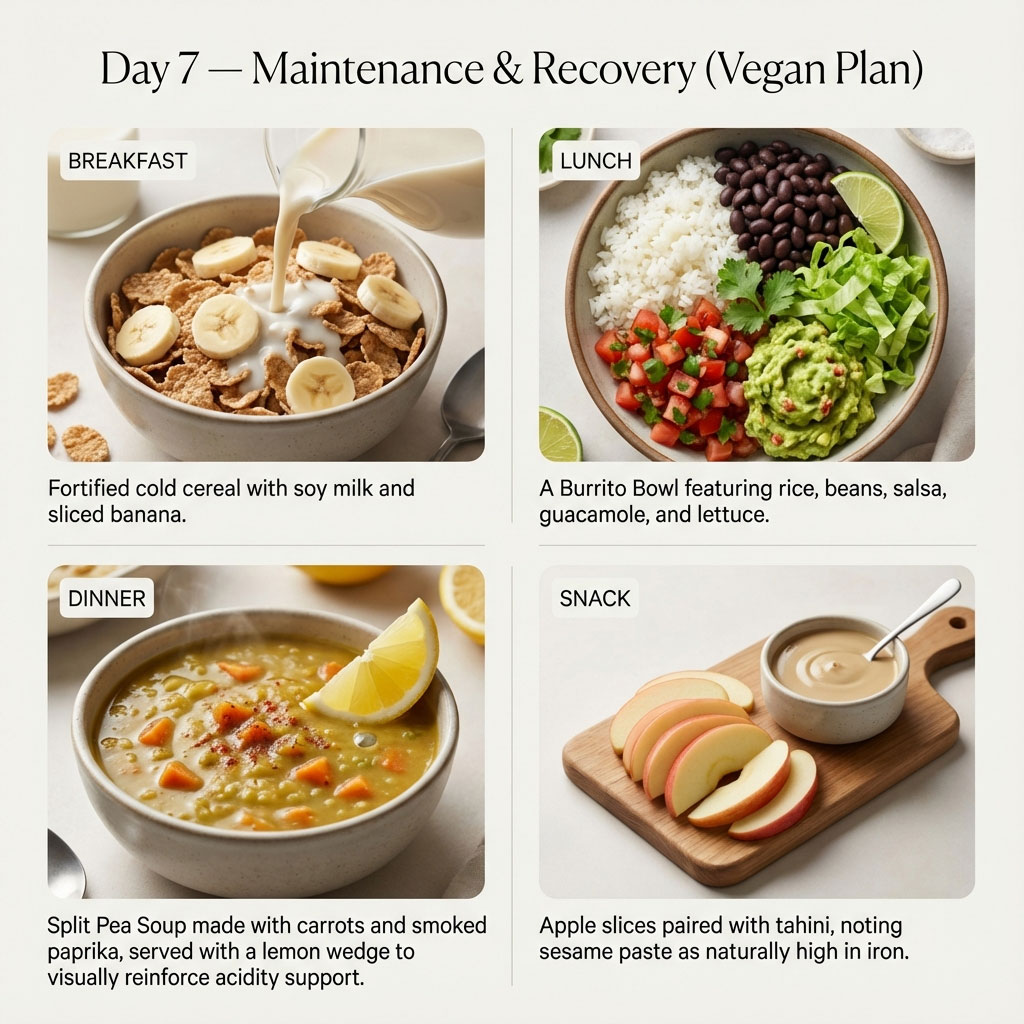
- Breakfast: Fortified cold cereal with Soy milk and sliced banana.
- Lunch: Burrito Bowl: Rice, beans, salsa, guacamole, and lettuce.
- Dinner: Split Pea Soup. Made with carrots and smoked paprika. Serve with a lemon wedge.
- Snack: Apple slices with Tahini (sesame paste is high iron).
Critical Comparison: Diet vs. Diet Strategy
It is vital to understand that the strategy changes based on your dietary restrictions. You cannot simply swap tofu for steak without adjusting the rest of the meal to compensate for the loss of heme iron.
Diet Strategy Overview
| Strategy Component | Non-Veg Plan | Vegetarian Plan | Vegan Plan |
| Primary Iron Source | Heme (Liver, Beef, Clams) | Eggs, Lentils, Fortified Grains | Molasses, Beans, Seeds |
| Absorption Rate | High (15-35%) | Medium (5-15%) | Low (2-10%) – Needs Help |
| Daily Iron Goal | ~18 mg | ~20 mg | ~27-32 mg |
| Key Risk | Constipation (Low Fiber) | Calcium Inhibition (Dairy) | Phytate Inhibition (Grains) |
| Essential Pairing | Veggies for Fiber | Vit C + Separating Dairy | Vit C + Cast Iron Cooking |
Advanced Lifestyle Tactics & Tools
Diet is the foundation, but there are specific lifestyle tools and tactics that can accelerate your results. These are the “force multipliers” of anemia recovery.
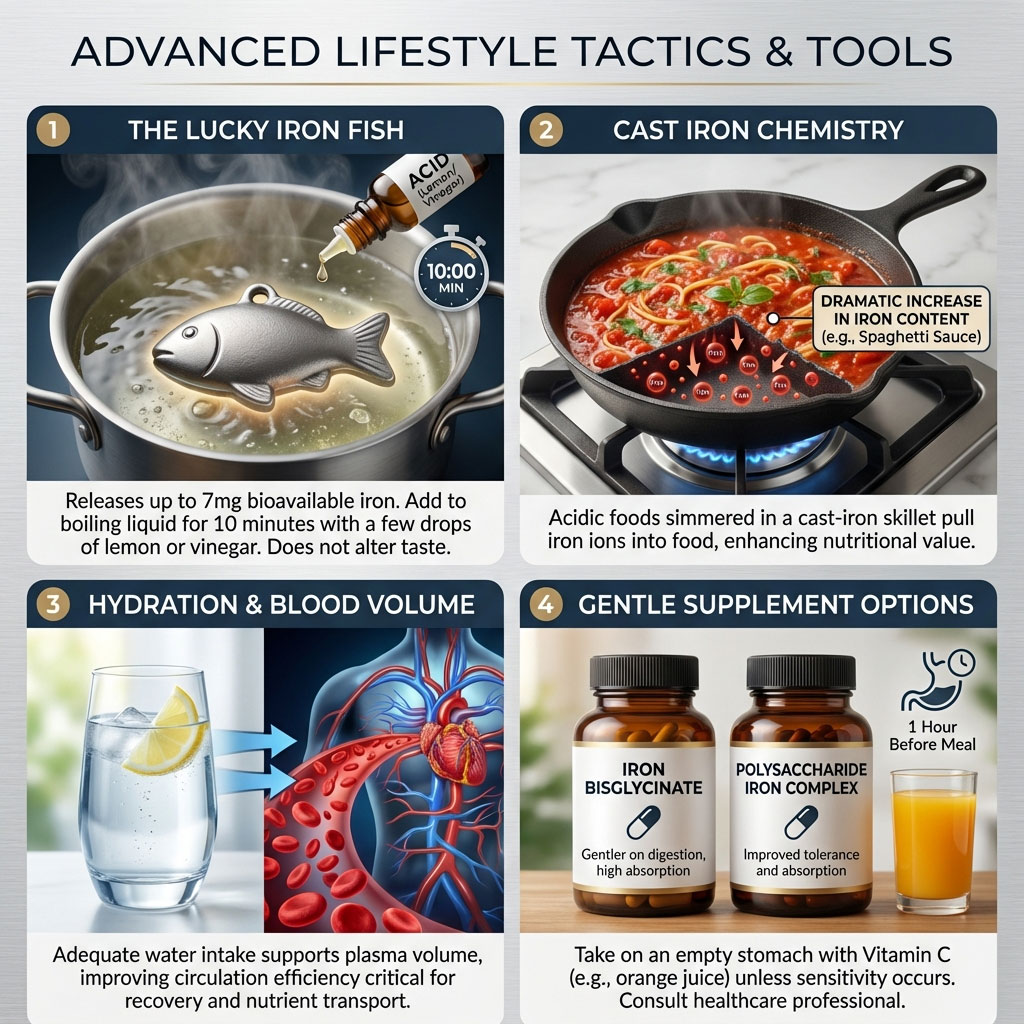
The “Lucky Iron Fish”
For Vegans and Vegetarians, reaching 30mg of iron through food alone is physically difficult due to the sheer volume of fiber and food required. The “Lucky Iron Fish” is a simple, effective cooking tool made of food-grade bioavailable iron. You simply drop the fish-shaped ingot into any boiling liquid (soup, stew, water for tea, or rice water) for 10 minutes. You must add a few drops of acidity (lemon or vinegar) to the water. This process releases a safe, consistent dose of absorbable iron into your food without changing the taste. Studies have shown it can provide up to 7mg of iron per use, covering a significant portion of your daily need.
The Chemistry of Cast Iron Cookware
We mentioned this in the meal plans, but the science is fascinating. When you cook acidic foods (pH below 7) in a seasoned cast iron skillet, iron ions are pulled from the pan into the food. A study published in the Journal of the American Dietetic Association confirmed that the iron content of foods like spaghetti sauce increased significantly (from 0.6mg to 5.7mg) after being cooked in a cast iron pot. This is essentially free supplementation. To maintain your pan, avoid using soap; simply scrub with salt and hot water, and keep it oiled to prevent rust.
Hydration & Blood Volume
When you are anemic, your body may reduce plasma volume. While this keeps the concentration of red blood cells seemingly stable, it reduces overall circulation efficiency. Drinking enough water helps increase plasma volume, which makes your blood circulate more efficiently. This helps deliver oxygen to your tissues even if your red blood cell count is still recovering.
Supplements: The “Gentle” Options
If your ferritin levels are below 15ng/mL, foods to increase hemoglobin may not work fast enough to restore your health. In this case, supplements are necessary. However, many doctors prescribe Ferrous Sulfate, which is harsh and often causes constipation and nausea.
- Iron Bisglycinate (Chelated Iron): This form is bound to glycine, an amino acid. It is much gentler on the stomach and has higher absorption rates than sulfate.
- Polysaccharide Iron Complex: This is a ferric iron complex that is also well-tolerated.
- Note: Always take supplements on an empty stomach with Vitamin C, unless you have a sensitive stomach, in which case taking them with a small amount of food is acceptable.
Troubleshooting: Why Is My Hemoglobin Not Rising?
You have followed the 7-day meal plan to increase hemoglobin, avoided coffee, and eaten liver. But your numbers haven’t moved. This “Refractory Iron Deficiency” can be caused by underlying issues.

1. Hidden Bacteria (H. Pylori)
Helicobacter Pylori is a bacteria that lives in the stomach lining of nearly 50% of the population. For many, it is asymptomatic. However, H. Pylori feeds on iron. It also lowers stomach acid, which makes it harder for you to absorb iron. If you have an H. Pylori infection, the bacteria might be stealing the iron from your food before you can absorb it. A simple breath test at your doctor’s office can rule this out.
2. Gluten Sensitivity & Celiac Disease
Iron absorption happens primarily in the duodenum, the very first section of the small intestine. Celiac disease damages the villi (tiny absorption fingers) in this exact area. If you have undiagnosed gluten sensitivity or Celiac disease, your gut lining might be too inflamed to absorb nutrients, no matter how much you eat. If you have anemia that won’t go away, ask for a Celiac panel.
3. Heavy Menstrual Bleeding (Menorrhagia)
For many women, the rate of iron loss during menstruation exceeds the biological limit of dietary intake. If you lose more than 80ml of blood per cycle, no amount of spinach or steak can replace the loss fast enough. This requires medical intervention (such as tranexamic acid or hormonal birth control) to stop the loss while diet helps rebuild the stores.
4. “Foot Strike” Hemolysis (Athletic Anemia)
Long-distance runners often suffer from low iron. This is partly due to sweating, but also due to a phenomenon called “foot strike hemolysis.” The repeated impact of feet hitting the pavement physically bursts red blood cells in the capillaries of the feet. Combined with hepcidin spikes from training inflammation, runners need significantly more iron than sedentary people.
Summary & Key Takeaways
Increasing hemoglobin naturally is a biological process that demands consistency over intensity. It is not a sprint; it is a marathon. While you will likely feel a surge in energy within 7 days due to better nutrition and hydration, your red blood cells require 2–4 weeks to fully regenerate.
Remember the Golden Equation of anemia recovery:
Iron + Acid (Vitamin C) – Inhibitors (Calcium/Caffeine) = Success.
Don’t guess about your health. Request a full iron panel including Ferritin, TIBC (Total Iron Binding Capacity), and Saturation to track your actual storage levels. Choose the protocol above that fits your lifestyle, stick to the 90-minute caffeine rule, and give your body the raw materials it needs to rebuild.
Frequently Asked Questions (FAQ)
Can hemoglobin really increase in 7 days with diet alone?
Your energy levels can improve significantly within 7 days due to better hydration and nutrient intake. However, biologically, it takes the body about 2 to 4 weeks to regenerate red blood cells and show a measurable increase in hemoglobin on a lab test. Think of the first week as “refueling the factory” so production can begin.
Which of these three plans increases hemoglobin the fastest?
Biologically, the Non-Vegetarian plan is the fastest. Heme iron found in meat and liver is absorbed at a rate of up to 35%, compared to 2-20% for plant iron. It bypasses many digestive inhibitors that slow down plant-based absorption.
Does cooking in cast iron really help anemia?
Yes. Research confirms that cooking acidic foods (like tomato sauce or chili) in a cast iron skillet for 45 minutes can increase the iron content of the food by up to 16%. It is a passive way to add foods to increase hemoglobin to your diet without taking pills.
What is the “90-Minute Rule”?
This rule states you should wait 90 minutes after an iron-rich meal before drinking tea, coffee, or milk. Tannins in tea and coffee and calcium in milk block iron absorption. Waiting allows your stomach to absorb the iron first before the inhibitors arrive.
Is a vegan diet safe for anemia?
Yes, it is safe, but it requires strategy. Because plant iron is harder to absorb, vegans need to consume approximately 1.8 times more iron than meat-eaters. You must rely on enhancers like Vitamin C and tools like cast iron cookware to close the gap.
Why is my iron low but hemoglobin normal?
This is called Functional Iron Deficiency. Your body is prioritizing keeping your blood (hemoglobin) normal by draining your storage tank (ferritin). You will feel tired, have brain fog, and perhaps experience hair loss long before your hemoglobin drops into the clinical “anemic” range.
What drinks block iron absorption?
The major blockers are black tea, green tea, coffee (both regular and decaf), red wine, and dairy milk. These contain tannins, polyphenols, or calcium that bind to iron and prevent it from entering the bloodstream. Avoid these during your main meals.
Are eggs good for anemia?
Yes, but they are tricky. The yolk is rich in iron, but the egg white contains a protein called phosvitin that inhibits absorption. The best way to eat eggs for anemia is to consume the whole egg and drink orange juice (Vitamin C) with the meal to counteract the inhibitor.
How much beef liver is safe to eat?
Beef liver is incredibly high in Vitamin A (Retinol). High doses of Retinol can be toxic over time. To avoid Vitamin A toxicity, limit liver consumption to once per week (about 3-4 oz). This is sufficient to boost your iron stores without risking toxicity.
Does soaking beans help?
Yes. Legumes contain phytates, which are “anti-nutrients” that block iron absorption. Soaking beans overnight and discarding the water before cooking can reduce phytate levels by up to 50%, making the iron more bioavailable.
Can I drink coffee if I have anemia?
You do not have to quit coffee, but you must time it correctly. Drink your coffee first thing in the morning, then wait 90 minutes before eating breakfast. Or, wait 90 minutes after lunch to have your afternoon cup.
Which fruit is best for hemoglobin?
Guava is the king of absorption enhancers because it has 4 times the Vitamin C of an orange. Pomegranate is also excellent as it contains small amounts of iron and Vitamin C. Prunes (dried plums) are great for their iron content and digestive benefits.
Scientific References & Data Sources
To verify the medical claims, nutritional data, and study results mentioned in this article, please refer to the following direct sources from the National Institutes of Health (NIH), the USDA, and peer-reviewed medical journals:
- Iron Absorption Mechanics (Heme vs. Non-Heme):
- Source: National Institutes of Health (NIH) Office of Dietary Supplements.
- Verification Link: Iron – Health Professional Fact Sheet (NIH.gov)
- Relevance: Confirms bioavailability data (14-18% for mixed diets vs. 5-12% for vegetarian diets) and the role of inhibitors like phytates and polyphenols.
- Vitamin C & Iron Synergy (The 300% Increase):
- Source: American Journal of Clinical Nutrition / PubMed Central.
- Study: “Interaction of vitamin C and iron” (Hallberg et al.).
- Verification Link: PubMed: Ascorbic acid facilitates iron absorption
- Relevance: Validates that adding ascorbic acid (Vitamin C) to a meal significantly counters the effects of phytates and tannins, increasing absorption.
- Cast Iron Cookware Study:
- Source: Journal of the American Dietetic Association.
- Study: “Iron content of food cooked in iron utensils” (Brittin & Nossaman).
- Verification Link: PubMed: Iron content of food cooked in iron utensils
- Relevance: Provides the data supporting the increase of iron content in acidic foods (like tomato sauce) when cooked in cast iron.
- Nutritional Value & Milligram Counts:
- Source: U.S. Department of Agriculture (USDA) FoodData Central.
- Verification Link: USDA FoodData Central Search
- Relevance: The official US government database used to calculate the 3mg, 5mg, and 18mg iron counts listed in the meal plans.
- Hepcidin & Inflammation (Anemia of Chronic Disease):
- Source: National Institute of Diabetes and Digestive and Kidney Diseases (NIDDK).
- Verification Link: Anemia of Inflammation and Chronic Disease
- Relevance: Explains the mechanism of hepcidin blocking iron absorption during periods of stress or illness.
Disclaimer: The content provided in this article is for educational and informational purposes only and is not intended as medical advice, diagnosis, or treatment. The meal plans and nutritional strategies listed are based on general dietary guidelines. Always consult with a qualified healthcare professional or physician before making significant changes to your diet, starting supplements, or if you suspect you have a medical condition such as anemia. Individual nutritional needs may vary based on age, gender, and health status.

